Wider Professional Practice and Development in Education and Training
VerifiedAdded on 2023/06/08
|17
|5607
|354
AI Summary
This report discusses the concept of professionalism and dual professionalism in training and education, the impact of social, political, and economic components on education policies, and the role of stakeholders and external bodies in education and training. It also justifies key aspects of policies, codes of practice, and guidelines of the organization and analyzes the impact of organizational requirements and expectations on the curriculum practice in the area of business management.
Contribute Materials
Your contribution can guide someone’s learning journey. Share your
documents today.
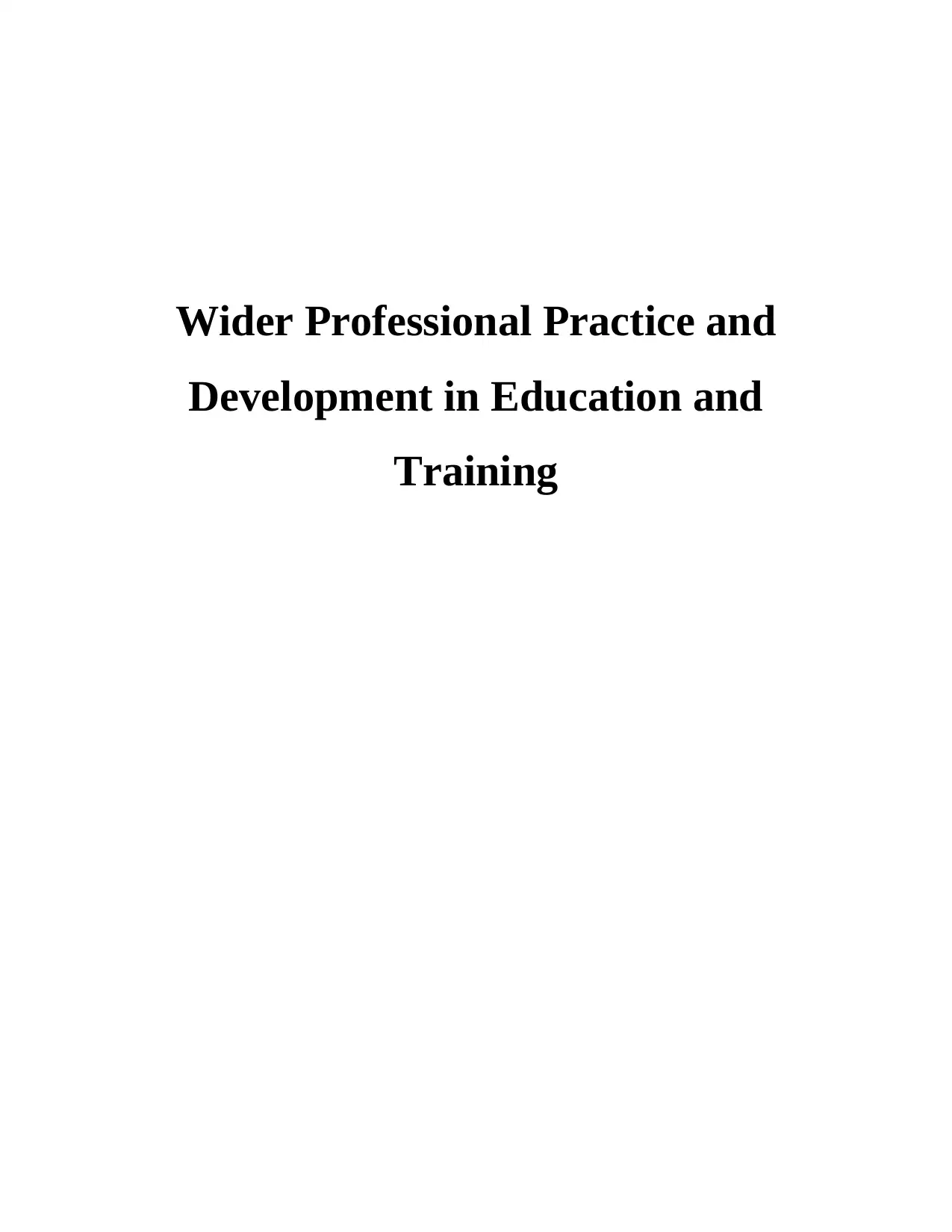
Wider Professional Practice and
Development in Education and
Training
Development in Education and
Training
Secure Best Marks with AI Grader
Need help grading? Try our AI Grader for instant feedback on your assignments.
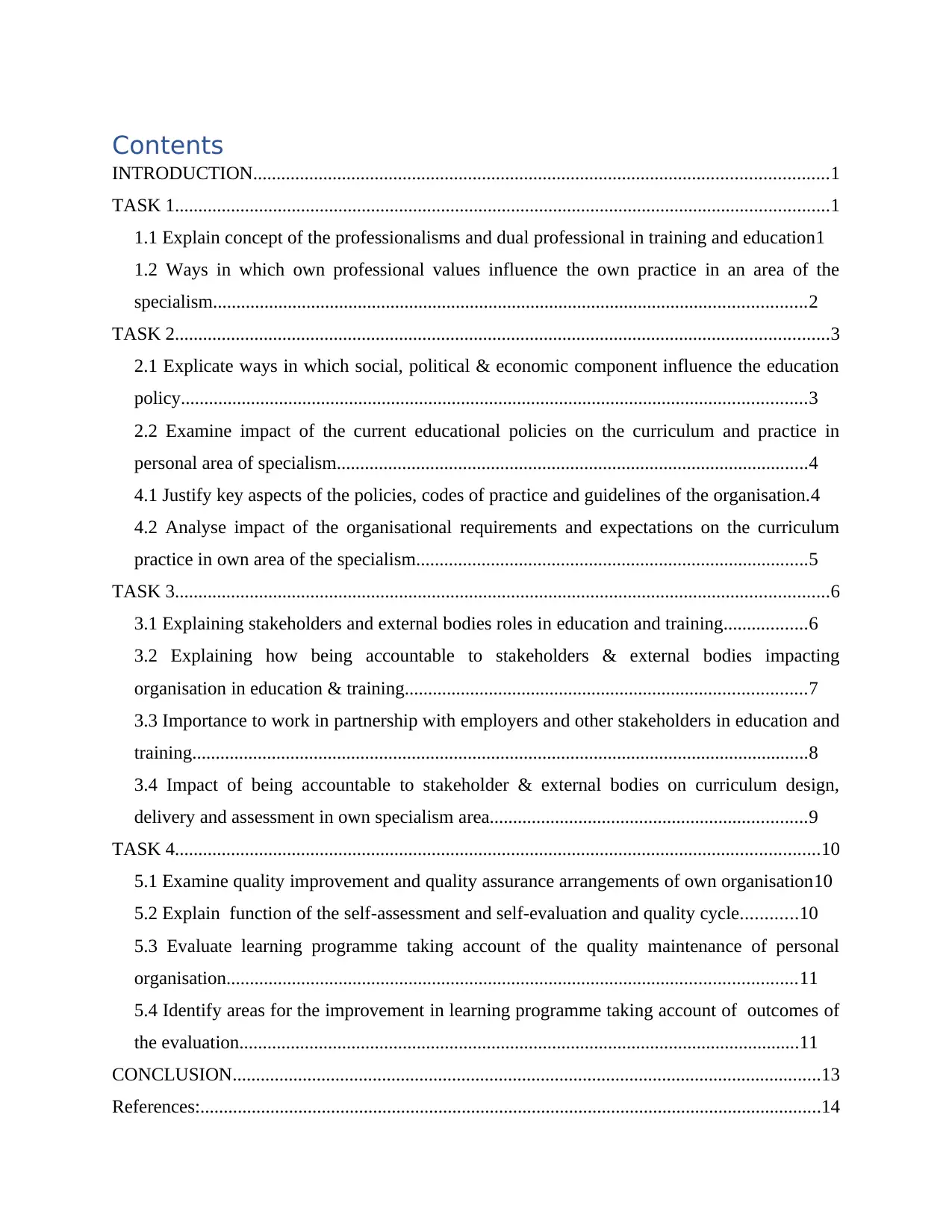
Contents
INTRODUCTION...........................................................................................................................1
TASK 1............................................................................................................................................1
1.1 Explain concept of the professionalisms and dual professional in training and education1
1.2 Ways in which own professional values influence the own practice in an area of the
specialism...............................................................................................................................2
TASK 2............................................................................................................................................3
2.1 Explicate ways in which social, political & economic component influence the education
policy......................................................................................................................................3
2.2 Examine impact of the current educational policies on the curriculum and practice in
personal area of specialism.....................................................................................................4
4.1 Justify key aspects of the policies, codes of practice and guidelines of the organisation.4
4.2 Analyse impact of the organisational requirements and expectations on the curriculum
practice in own area of the specialism....................................................................................5
TASK 3............................................................................................................................................6
3.1 Explaining stakeholders and external bodies roles in education and training..................6
3.2 Explaining how being accountable to stakeholders & external bodies impacting
organisation in education & training......................................................................................7
3.3 Importance to work in partnership with employers and other stakeholders in education and
training....................................................................................................................................8
3.4 Impact of being accountable to stakeholder & external bodies on curriculum design,
delivery and assessment in own specialism area....................................................................9
TASK 4..........................................................................................................................................10
5.1 Examine quality improvement and quality assurance arrangements of own organisation10
5.2 Explain function of the self-assessment and self-evaluation and quality cycle............10
5.3 Evaluate learning programme taking account of the quality maintenance of personal
organisation..........................................................................................................................11
5.4 Identify areas for the improvement in learning programme taking account of outcomes of
the evaluation........................................................................................................................11
CONCLUSION..............................................................................................................................13
References:.....................................................................................................................................14
INTRODUCTION...........................................................................................................................1
TASK 1............................................................................................................................................1
1.1 Explain concept of the professionalisms and dual professional in training and education1
1.2 Ways in which own professional values influence the own practice in an area of the
specialism...............................................................................................................................2
TASK 2............................................................................................................................................3
2.1 Explicate ways in which social, political & economic component influence the education
policy......................................................................................................................................3
2.2 Examine impact of the current educational policies on the curriculum and practice in
personal area of specialism.....................................................................................................4
4.1 Justify key aspects of the policies, codes of practice and guidelines of the organisation.4
4.2 Analyse impact of the organisational requirements and expectations on the curriculum
practice in own area of the specialism....................................................................................5
TASK 3............................................................................................................................................6
3.1 Explaining stakeholders and external bodies roles in education and training..................6
3.2 Explaining how being accountable to stakeholders & external bodies impacting
organisation in education & training......................................................................................7
3.3 Importance to work in partnership with employers and other stakeholders in education and
training....................................................................................................................................8
3.4 Impact of being accountable to stakeholder & external bodies on curriculum design,
delivery and assessment in own specialism area....................................................................9
TASK 4..........................................................................................................................................10
5.1 Examine quality improvement and quality assurance arrangements of own organisation10
5.2 Explain function of the self-assessment and self-evaluation and quality cycle............10
5.3 Evaluate learning programme taking account of the quality maintenance of personal
organisation..........................................................................................................................11
5.4 Identify areas for the improvement in learning programme taking account of outcomes of
the evaluation........................................................................................................................11
CONCLUSION..............................................................................................................................13
References:.....................................................................................................................................14

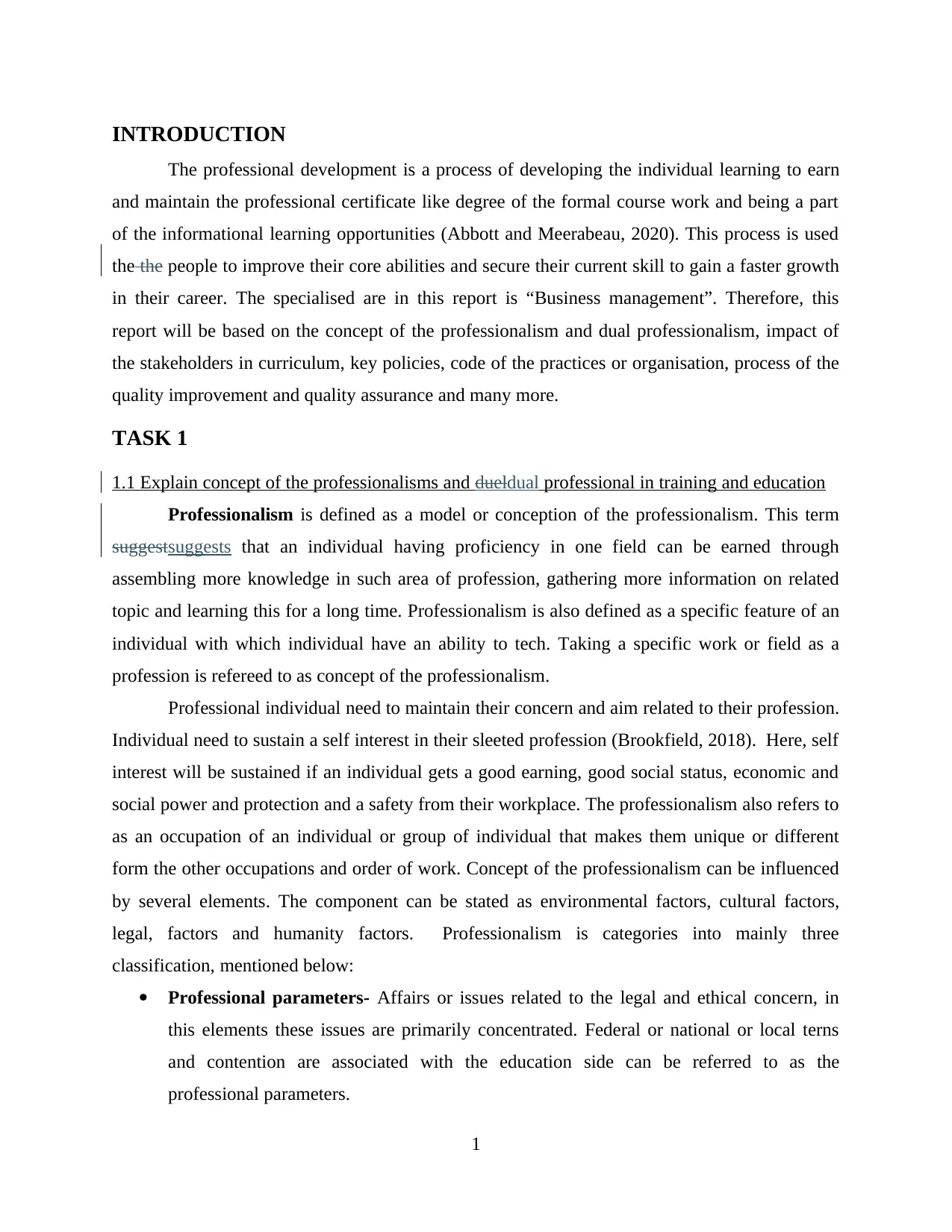
INTRODUCTION
The professional development is a process of developing the individual learning to earn
and maintain the professional certificate like degree of the formal course work and being a part
of the informational learning opportunities (Abbott and Meerabeau, 2020). This process is used
the the people to improve their core abilities and secure their current skill to gain a faster growth
in their career. The specialised are in this report is “Business management”. Therefore, this
report will be based on the concept of the professionalism and dual professionalism, impact of
the stakeholders in curriculum, key policies, code of the practices or organisation, process of the
quality improvement and quality assurance and many more.
TASK 1
1.1 Explain concept of the professionalisms and dueldual professional in training and education
Professionalism is defined as a model or conception of the professionalism. This term
suggestsuggests that an individual having proficiency in one field can be earned through
assembling more knowledge in such area of profession, gathering more information on related
topic and learning this for a long time. Professionalism is also defined as a specific feature of an
individual with which individual have an ability to tech. Taking a specific work or field as a
profession is refereed to as concept of the professionalism.
Professional individual need to maintain their concern and aim related to their profession.
Individual need to sustain a self interest in their sleeted profession (Brookfield, 2018). Here, self
interest will be sustained if an individual gets a good earning, good social status, economic and
social power and protection and a safety from their workplace. The professionalism also refers to
as an occupation of an individual or group of individual that makes them unique or different
form the other occupations and order of work. Concept of the professionalism can be influenced
by several elements. The component can be stated as environmental factors, cultural factors,
legal, factors and humanity factors. Professionalism is categories into mainly three
classification, mentioned below:
Professional parameters- Affairs or issues related to the legal and ethical concern, in
this elements these issues are primarily concentrated. Federal or national or local terns
and contention are associated with the education side can be referred to as the
professional parameters.
1
The professional development is a process of developing the individual learning to earn
and maintain the professional certificate like degree of the formal course work and being a part
of the informational learning opportunities (Abbott and Meerabeau, 2020). This process is used
the the people to improve their core abilities and secure their current skill to gain a faster growth
in their career. The specialised are in this report is “Business management”. Therefore, this
report will be based on the concept of the professionalism and dual professionalism, impact of
the stakeholders in curriculum, key policies, code of the practices or organisation, process of the
quality improvement and quality assurance and many more.
TASK 1
1.1 Explain concept of the professionalisms and dueldual professional in training and education
Professionalism is defined as a model or conception of the professionalism. This term
suggestsuggests that an individual having proficiency in one field can be earned through
assembling more knowledge in such area of profession, gathering more information on related
topic and learning this for a long time. Professionalism is also defined as a specific feature of an
individual with which individual have an ability to tech. Taking a specific work or field as a
profession is refereed to as concept of the professionalism.
Professional individual need to maintain their concern and aim related to their profession.
Individual need to sustain a self interest in their sleeted profession (Brookfield, 2018). Here, self
interest will be sustained if an individual gets a good earning, good social status, economic and
social power and protection and a safety from their workplace. The professionalism also refers to
as an occupation of an individual or group of individual that makes them unique or different
form the other occupations and order of work. Concept of the professionalism can be influenced
by several elements. The component can be stated as environmental factors, cultural factors,
legal, factors and humanity factors. Professionalism is categories into mainly three
classification, mentioned below:
Professional parameters- Affairs or issues related to the legal and ethical concern, in
this elements these issues are primarily concentrated. Federal or national or local terns
and contention are associated with the education side can be referred to as the
professional parameters.
1
Secure Best Marks with AI Grader
Need help grading? Try our AI Grader for instant feedback on your assignments.
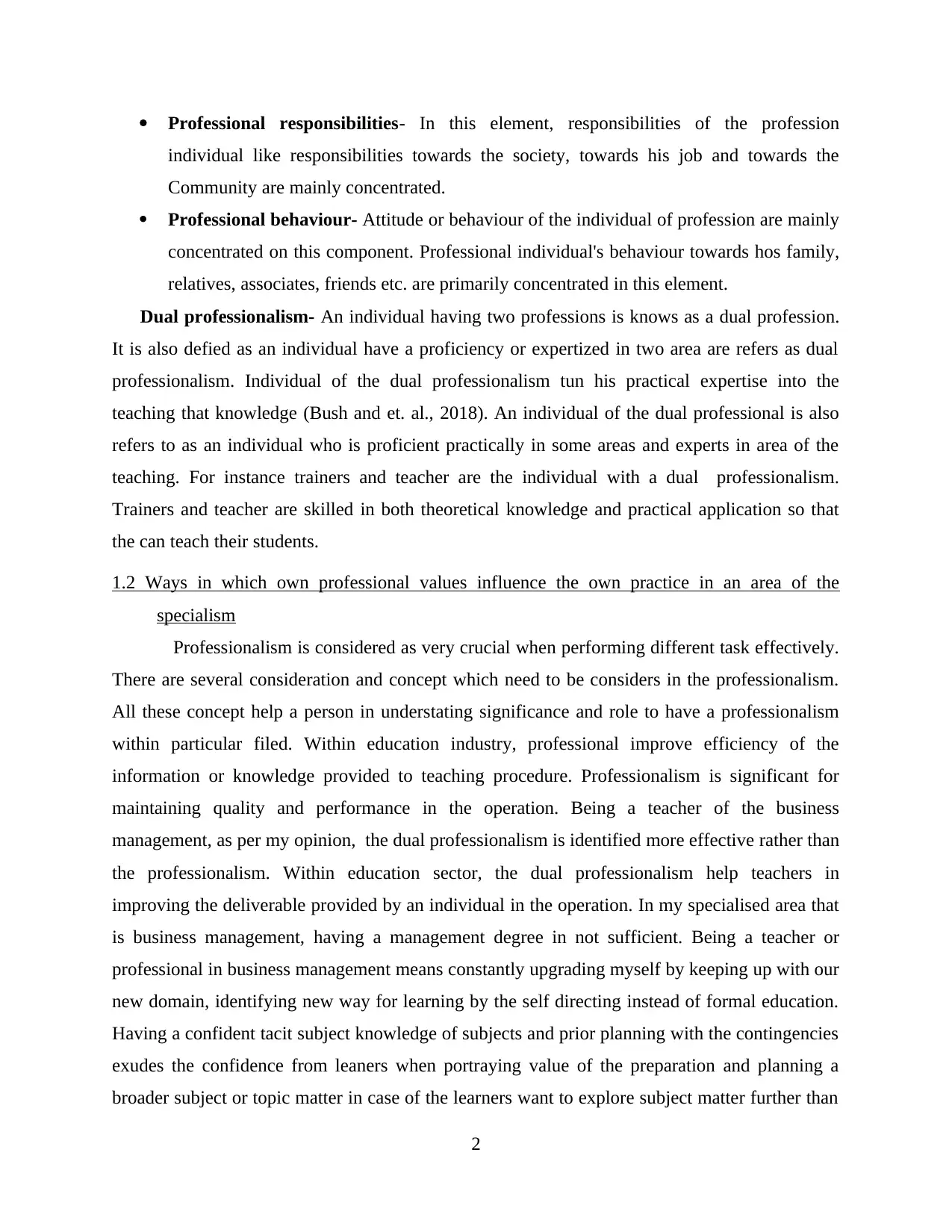
Professional responsibilities- In this element, responsibilities of the profession
individual like responsibilities towards the society, towards his job and towards the
Community are mainly concentrated.
Professional behaviour- Attitude or behaviour of the individual of profession are mainly
concentrated on this component. Professional individual's behaviour towards hos family,
relatives, associates, friends etc. are primarily concentrated in this element.
Dual professionalism- An individual having two professions is knows as a dual profession.
It is also defied as an individual have a proficiency or expertized in two area are refers as dual
professionalism. Individual of the dual professionalism tun his practical expertise into the
teaching that knowledge (Bush and et. al., 2018). An individual of the dual professional is also
refers to as an individual who is proficient practically in some areas and experts in area of the
teaching. For instance trainers and teacher are the individual with a dual professionalism.
Trainers and teacher are skilled in both theoretical knowledge and practical application so that
the can teach their students.
1.2 Ways in which own professional values influence the own practice in an area of the
specialism
Professionalism is considered as very crucial when performing different task effectively.
There are several consideration and concept which need to be considers in the professionalism.
All these concept help a person in understating significance and role to have a professionalism
within particular filed. Within education industry, professional improve efficiency of the
information or knowledge provided to teaching procedure. Professionalism is significant for
maintaining quality and performance in the operation. Being a teacher of the business
management, as per my opinion, the dual professionalism is identified more effective rather than
the professionalism. Within education sector, the dual professionalism help teachers in
improving the deliverable provided by an individual in the operation. In my specialised area that
is business management, having a management degree in not sufficient. Being a teacher or
professional in business management means constantly upgrading myself by keeping up with our
new domain, identifying new way for learning by the self directing instead of formal education.
Having a confident tacit subject knowledge of subjects and prior planning with the contingencies
exudes the confidence from leaners when portraying value of the preparation and planning a
broader subject or topic matter in case of the learners want to explore subject matter further than
2
individual like responsibilities towards the society, towards his job and towards the
Community are mainly concentrated.
Professional behaviour- Attitude or behaviour of the individual of profession are mainly
concentrated on this component. Professional individual's behaviour towards hos family,
relatives, associates, friends etc. are primarily concentrated in this element.
Dual professionalism- An individual having two professions is knows as a dual profession.
It is also defied as an individual have a proficiency or expertized in two area are refers as dual
professionalism. Individual of the dual professionalism tun his practical expertise into the
teaching that knowledge (Bush and et. al., 2018). An individual of the dual professional is also
refers to as an individual who is proficient practically in some areas and experts in area of the
teaching. For instance trainers and teacher are the individual with a dual professionalism.
Trainers and teacher are skilled in both theoretical knowledge and practical application so that
the can teach their students.
1.2 Ways in which own professional values influence the own practice in an area of the
specialism
Professionalism is considered as very crucial when performing different task effectively.
There are several consideration and concept which need to be considers in the professionalism.
All these concept help a person in understating significance and role to have a professionalism
within particular filed. Within education industry, professional improve efficiency of the
information or knowledge provided to teaching procedure. Professionalism is significant for
maintaining quality and performance in the operation. Being a teacher of the business
management, as per my opinion, the dual professionalism is identified more effective rather than
the professionalism. Within education sector, the dual professionalism help teachers in
improving the deliverable provided by an individual in the operation. In my specialised area that
is business management, having a management degree in not sufficient. Being a teacher or
professional in business management means constantly upgrading myself by keeping up with our
new domain, identifying new way for learning by the self directing instead of formal education.
Having a confident tacit subject knowledge of subjects and prior planning with the contingencies
exudes the confidence from leaners when portraying value of the preparation and planning a
broader subject or topic matter in case of the learners want to explore subject matter further than
2
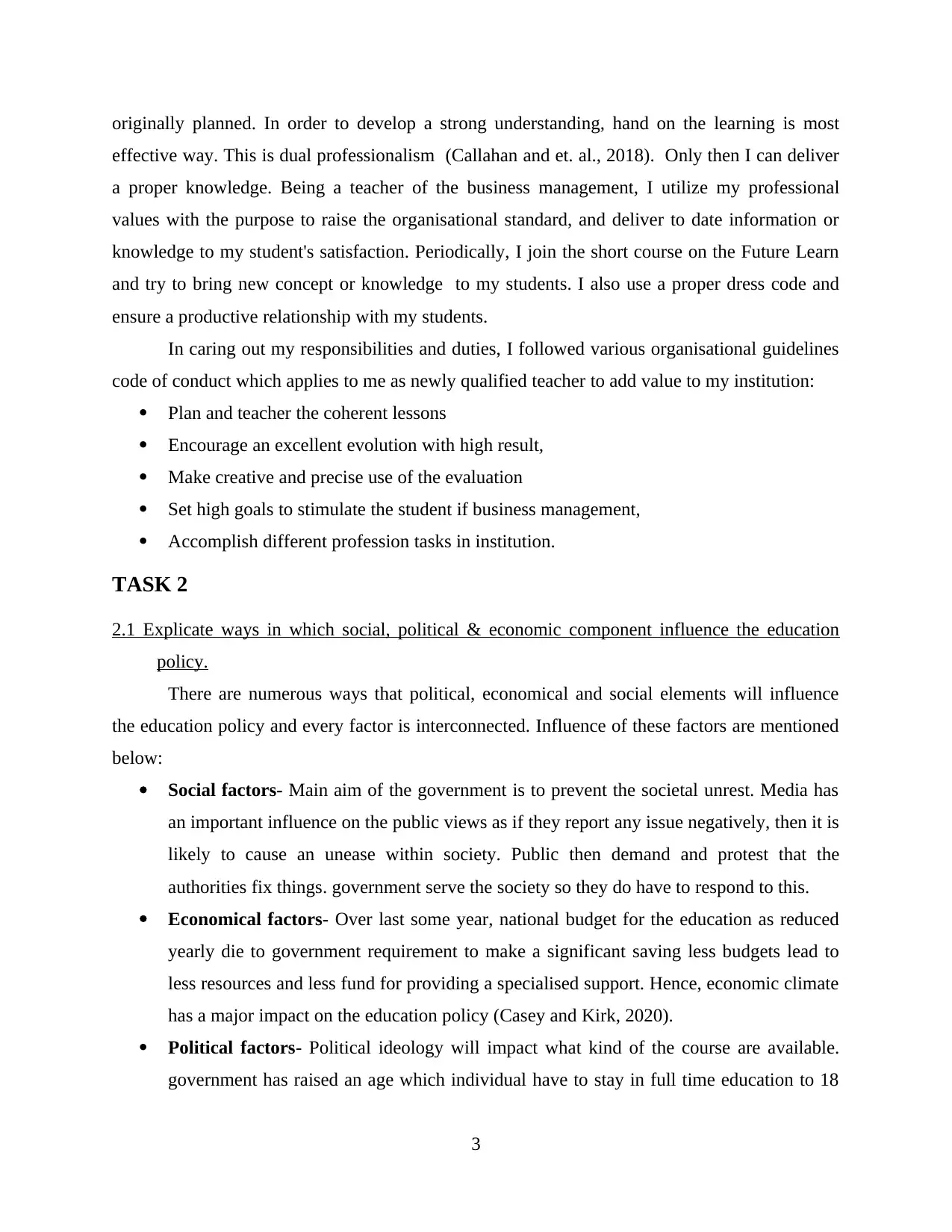
originally planned. In order to develop a strong understanding, hand on the learning is most
effective way. This is dual professionalism (Callahan and et. al., 2018). Only then I can deliver
a proper knowledge. Being a teacher of the business management, I utilize my professional
values with the purpose to raise the organisational standard, and deliver to date information or
knowledge to my student's satisfaction. Periodically, I join the short course on the Future Learn
and try to bring new concept or knowledge to my students. I also use a proper dress code and
ensure a productive relationship with my students.
In caring out my responsibilities and duties, I followed various organisational guidelines
code of conduct which applies to me as newly qualified teacher to add value to my institution:
Plan and teacher the coherent lessons
Encourage an excellent evolution with high result,
Make creative and precise use of the evaluation
Set high goals to stimulate the student if business management,
Accomplish different profession tasks in institution.
TASK 2
2.1 Explicate ways in which social, political & economic component influence the education
policy.
There are numerous ways that political, economical and social elements will influence
the education policy and every factor is interconnected. Influence of these factors are mentioned
below:
Social factors- Main aim of the government is to prevent the societal unrest. Media has
an important influence on the public views as if they report any issue negatively, then it is
likely to cause an unease within society. Public then demand and protest that the
authorities fix things. government serve the society so they do have to respond to this.
Economical factors- Over last some year, national budget for the education as reduced
yearly die to government requirement to make a significant saving less budgets lead to
less resources and less fund for providing a specialised support. Hence, economic climate
has a major impact on the education policy (Casey and Kirk, 2020).
Political factors- Political ideology will impact what kind of the course are available.
government has raised an age which individual have to stay in full time education to 18
3
effective way. This is dual professionalism (Callahan and et. al., 2018). Only then I can deliver
a proper knowledge. Being a teacher of the business management, I utilize my professional
values with the purpose to raise the organisational standard, and deliver to date information or
knowledge to my student's satisfaction. Periodically, I join the short course on the Future Learn
and try to bring new concept or knowledge to my students. I also use a proper dress code and
ensure a productive relationship with my students.
In caring out my responsibilities and duties, I followed various organisational guidelines
code of conduct which applies to me as newly qualified teacher to add value to my institution:
Plan and teacher the coherent lessons
Encourage an excellent evolution with high result,
Make creative and precise use of the evaluation
Set high goals to stimulate the student if business management,
Accomplish different profession tasks in institution.
TASK 2
2.1 Explicate ways in which social, political & economic component influence the education
policy.
There are numerous ways that political, economical and social elements will influence
the education policy and every factor is interconnected. Influence of these factors are mentioned
below:
Social factors- Main aim of the government is to prevent the societal unrest. Media has
an important influence on the public views as if they report any issue negatively, then it is
likely to cause an unease within society. Public then demand and protest that the
authorities fix things. government serve the society so they do have to respond to this.
Economical factors- Over last some year, national budget for the education as reduced
yearly die to government requirement to make a significant saving less budgets lead to
less resources and less fund for providing a specialised support. Hence, economic climate
has a major impact on the education policy (Casey and Kirk, 2020).
Political factors- Political ideology will impact what kind of the course are available.
government has raised an age which individual have to stay in full time education to 18
3
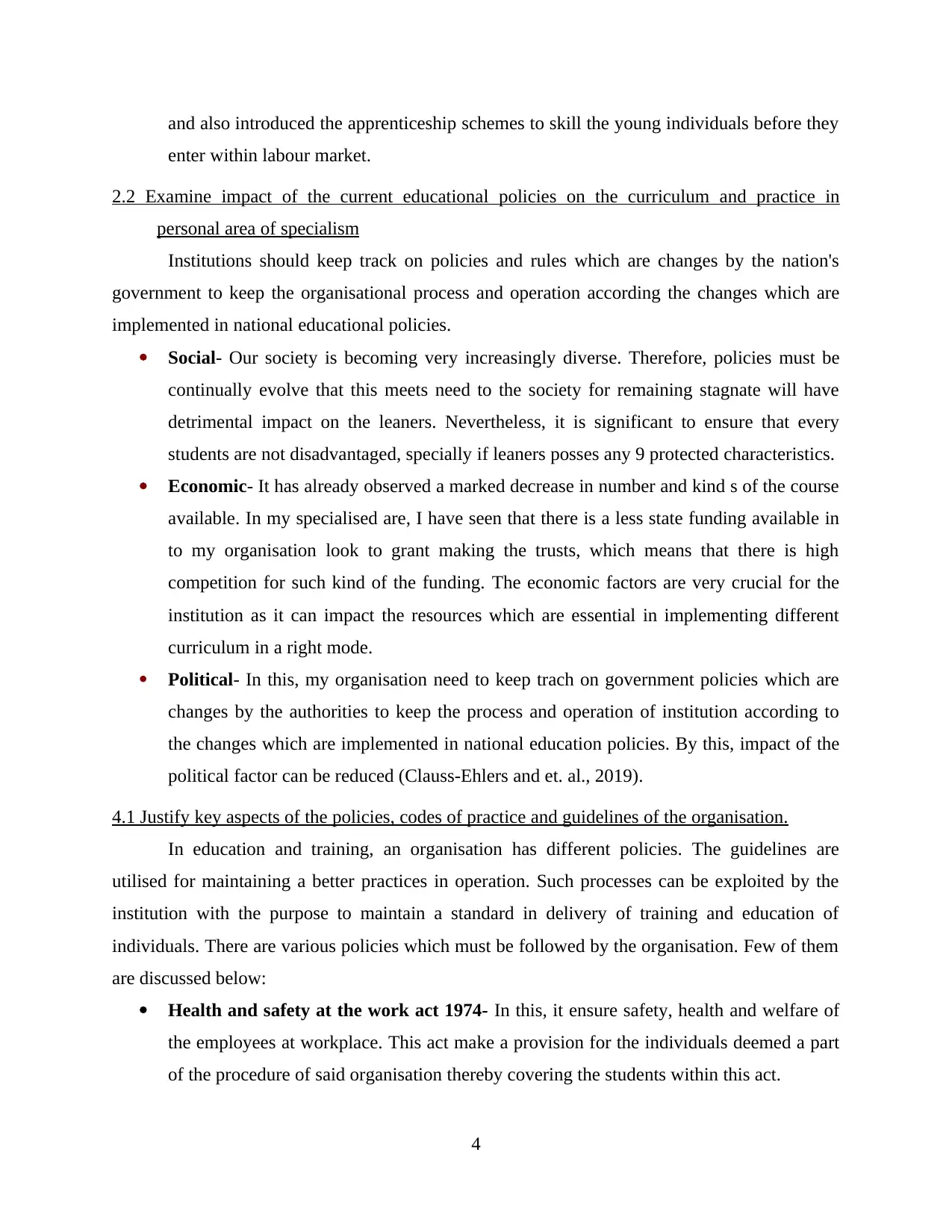
and also introduced the apprenticeship schemes to skill the young individuals before they
enter within labour market.
2.2 Examine impact of the current educational policies on the curriculum and practice in
personal area of specialism
Institutions should keep track on policies and rules which are changes by the nation's
government to keep the organisational process and operation according the changes which are
implemented in national educational policies.
Social- Our society is becoming very increasingly diverse. Therefore, policies must be
continually evolve that this meets need to the society for remaining stagnate will have
detrimental impact on the leaners. Nevertheless, it is significant to ensure that every
students are not disadvantaged, specially if leaners posses any 9 protected characteristics.
Economic- It has already observed a marked decrease in number and kind s of the course
available. In my specialised are, I have seen that there is a less state funding available in
to my organisation look to grant making the trusts, which means that there is high
competition for such kind of the funding. The economic factors are very crucial for the
institution as it can impact the resources which are essential in implementing different
curriculum in a right mode.
Political- In this, my organisation need to keep trach on government policies which are
changes by the authorities to keep the process and operation of institution according to
the changes which are implemented in national education policies. By this, impact of the
political factor can be reduced (Clauss-Ehlers and et. al., 2019).
4.1 Justify key aspects of the policies, codes of practice and guidelines of the organisation.
In education and training, an organisation has different policies. The guidelines are
utilised for maintaining a better practices in operation. Such processes can be exploited by the
institution with the purpose to maintain a standard in delivery of training and education of
individuals. There are various policies which must be followed by the organisation. Few of them
are discussed below:
Health and safety at the work act 1974- In this, it ensure safety, health and welfare of
the employees at workplace. This act make a provision for the individuals deemed a part
of the procedure of said organisation thereby covering the students within this act.
4
enter within labour market.
2.2 Examine impact of the current educational policies on the curriculum and practice in
personal area of specialism
Institutions should keep track on policies and rules which are changes by the nation's
government to keep the organisational process and operation according the changes which are
implemented in national educational policies.
Social- Our society is becoming very increasingly diverse. Therefore, policies must be
continually evolve that this meets need to the society for remaining stagnate will have
detrimental impact on the leaners. Nevertheless, it is significant to ensure that every
students are not disadvantaged, specially if leaners posses any 9 protected characteristics.
Economic- It has already observed a marked decrease in number and kind s of the course
available. In my specialised are, I have seen that there is a less state funding available in
to my organisation look to grant making the trusts, which means that there is high
competition for such kind of the funding. The economic factors are very crucial for the
institution as it can impact the resources which are essential in implementing different
curriculum in a right mode.
Political- In this, my organisation need to keep trach on government policies which are
changes by the authorities to keep the process and operation of institution according to
the changes which are implemented in national education policies. By this, impact of the
political factor can be reduced (Clauss-Ehlers and et. al., 2019).
4.1 Justify key aspects of the policies, codes of practice and guidelines of the organisation.
In education and training, an organisation has different policies. The guidelines are
utilised for maintaining a better practices in operation. Such processes can be exploited by the
institution with the purpose to maintain a standard in delivery of training and education of
individuals. There are various policies which must be followed by the organisation. Few of them
are discussed below:
Health and safety at the work act 1974- In this, it ensure safety, health and welfare of
the employees at workplace. This act make a provision for the individuals deemed a part
of the procedure of said organisation thereby covering the students within this act.
4
Paraphrase This Document
Need a fresh take? Get an instant paraphrase of this document with our AI Paraphraser
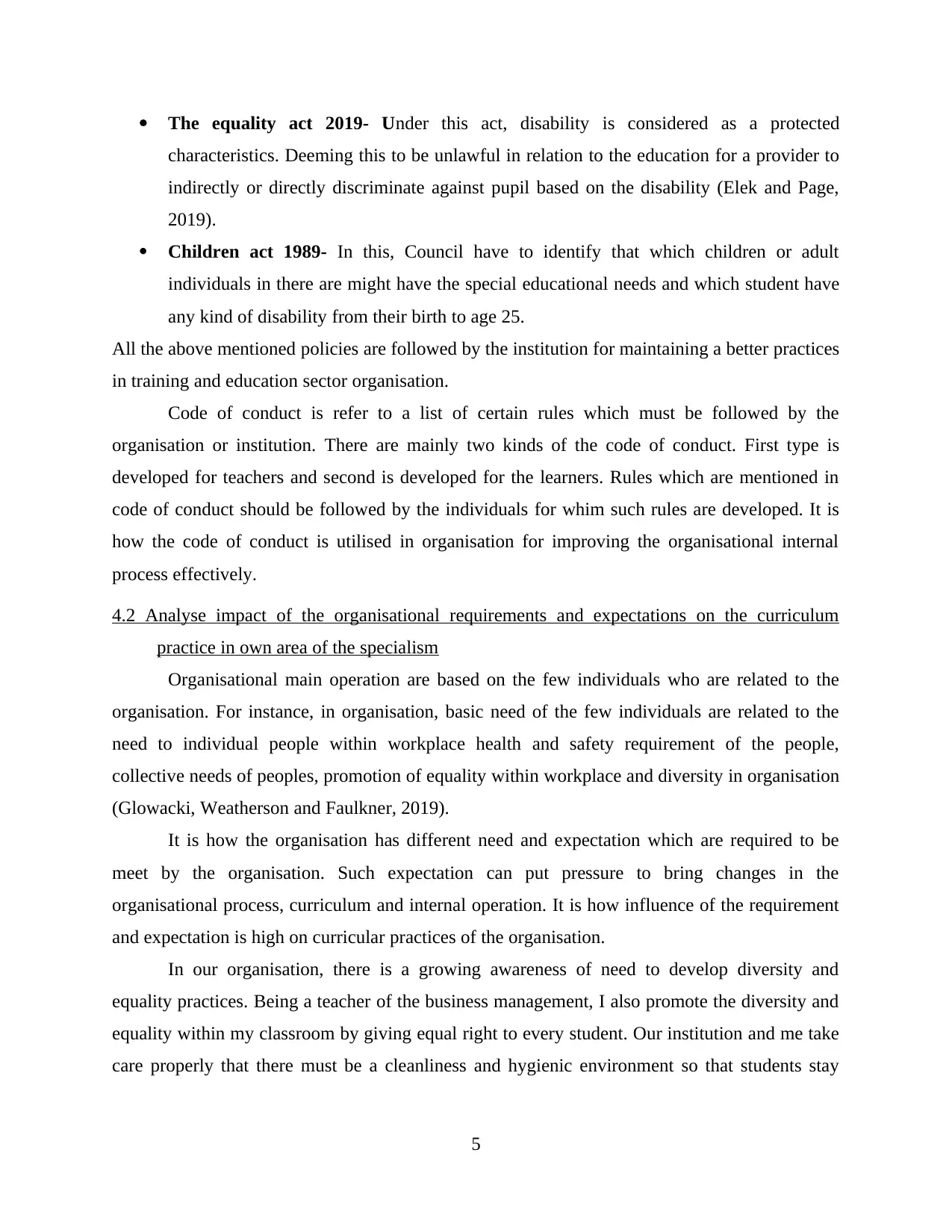
The equality act 2019- Under this act, disability is considered as a protected
characteristics. Deeming this to be unlawful in relation to the education for a provider to
indirectly or directly discriminate against pupil based on the disability (Elek and Page,
2019).
Children act 1989- In this, Council have to identify that which children or adult
individuals in there are might have the special educational needs and which student have
any kind of disability from their birth to age 25.
All the above mentioned policies are followed by the institution for maintaining a better practices
in training and education sector organisation.
Code of conduct is refer to a list of certain rules which must be followed by the
organisation or institution. There are mainly two kinds of the code of conduct. First type is
developed for teachers and second is developed for the learners. Rules which are mentioned in
code of conduct should be followed by the individuals for whim such rules are developed. It is
how the code of conduct is utilised in organisation for improving the organisational internal
process effectively.
4.2 Analyse impact of the organisational requirements and expectations on the curriculum
practice in own area of the specialism
Organisational main operation are based on the few individuals who are related to the
organisation. For instance, in organisation, basic need of the few individuals are related to the
need to individual people within workplace health and safety requirement of the people,
collective needs of peoples, promotion of equality within workplace and diversity in organisation
(Glowacki, Weatherson and Faulkner, 2019).
It is how the organisation has different need and expectation which are required to be
meet by the organisation. Such expectation can put pressure to bring changes in the
organisational process, curriculum and internal operation. It is how influence of the requirement
and expectation is high on curricular practices of the organisation.
In our organisation, there is a growing awareness of need to develop diversity and
equality practices. Being a teacher of the business management, I also promote the diversity and
equality within my classroom by giving equal right to every student. Our institution and me take
care properly that there must be a cleanliness and hygienic environment so that students stay
5
characteristics. Deeming this to be unlawful in relation to the education for a provider to
indirectly or directly discriminate against pupil based on the disability (Elek and Page,
2019).
Children act 1989- In this, Council have to identify that which children or adult
individuals in there are might have the special educational needs and which student have
any kind of disability from their birth to age 25.
All the above mentioned policies are followed by the institution for maintaining a better practices
in training and education sector organisation.
Code of conduct is refer to a list of certain rules which must be followed by the
organisation or institution. There are mainly two kinds of the code of conduct. First type is
developed for teachers and second is developed for the learners. Rules which are mentioned in
code of conduct should be followed by the individuals for whim such rules are developed. It is
how the code of conduct is utilised in organisation for improving the organisational internal
process effectively.
4.2 Analyse impact of the organisational requirements and expectations on the curriculum
practice in own area of the specialism
Organisational main operation are based on the few individuals who are related to the
organisation. For instance, in organisation, basic need of the few individuals are related to the
need to individual people within workplace health and safety requirement of the people,
collective needs of peoples, promotion of equality within workplace and diversity in organisation
(Glowacki, Weatherson and Faulkner, 2019).
It is how the organisation has different need and expectation which are required to be
meet by the organisation. Such expectation can put pressure to bring changes in the
organisational process, curriculum and internal operation. It is how influence of the requirement
and expectation is high on curricular practices of the organisation.
In our organisation, there is a growing awareness of need to develop diversity and
equality practices. Being a teacher of the business management, I also promote the diversity and
equality within my classroom by giving equal right to every student. Our institution and me take
care properly that there must be a cleanliness and hygienic environment so that students stay
5
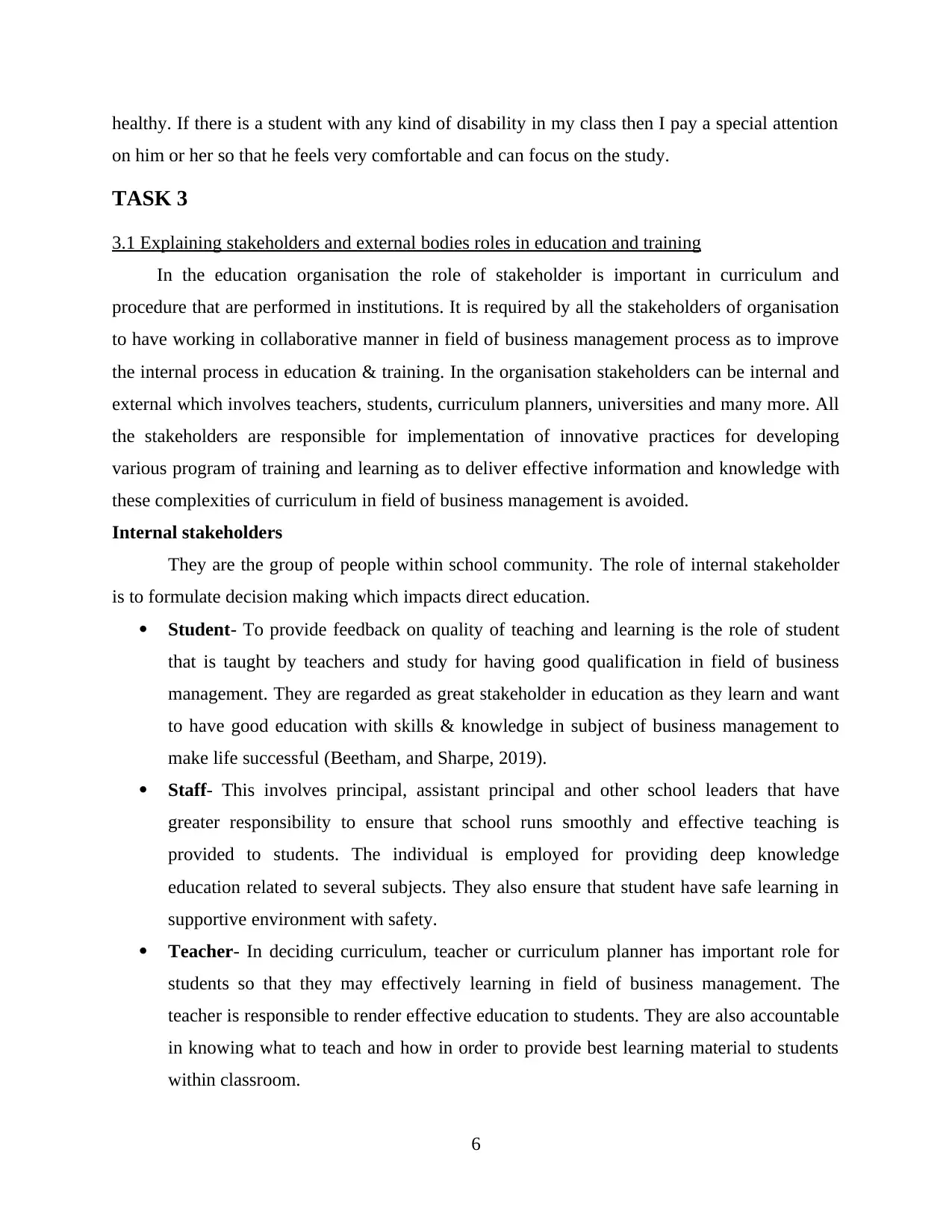
healthy. If there is a student with any kind of disability in my class then I pay a special attention
on him or her so that he feels very comfortable and can focus on the study.
TASK 3
3.1 Explaining stakeholders and external bodies roles in education and training
In the education organisation the role of stakeholder is important in curriculum and
procedure that are performed in institutions. It is required by all the stakeholders of organisation
to have working in collaborative manner in field of business management process as to improve
the internal process in education & training. In the organisation stakeholders can be internal and
external which involves teachers, students, curriculum planners, universities and many more. All
the stakeholders are responsible for implementation of innovative practices for developing
various program of training and learning as to deliver effective information and knowledge with
these complexities of curriculum in field of business management is avoided.
Internal stakeholders
They are the group of people within school community. The role of internal stakeholder
is to formulate decision making which impacts direct education.
Student- To provide feedback on quality of teaching and learning is the role of student
that is taught by teachers and study for having good qualification in field of business
management. They are regarded as great stakeholder in education as they learn and want
to have good education with skills & knowledge in subject of business management to
make life successful (Beetham, and Sharpe, 2019).
Staff- This involves principal, assistant principal and other school leaders that have
greater responsibility to ensure that school runs smoothly and effective teaching is
provided to students. The individual is employed for providing deep knowledge
education related to several subjects. They also ensure that student have safe learning in
supportive environment with safety.
Teacher- In deciding curriculum, teacher or curriculum planner has important role for
students so that they may effectively learning in field of business management. The
teacher is responsible to render effective education to students. They are also accountable
in knowing what to teach and how in order to provide best learning material to students
within classroom.
6
on him or her so that he feels very comfortable and can focus on the study.
TASK 3
3.1 Explaining stakeholders and external bodies roles in education and training
In the education organisation the role of stakeholder is important in curriculum and
procedure that are performed in institutions. It is required by all the stakeholders of organisation
to have working in collaborative manner in field of business management process as to improve
the internal process in education & training. In the organisation stakeholders can be internal and
external which involves teachers, students, curriculum planners, universities and many more. All
the stakeholders are responsible for implementation of innovative practices for developing
various program of training and learning as to deliver effective information and knowledge with
these complexities of curriculum in field of business management is avoided.
Internal stakeholders
They are the group of people within school community. The role of internal stakeholder
is to formulate decision making which impacts direct education.
Student- To provide feedback on quality of teaching and learning is the role of student
that is taught by teachers and study for having good qualification in field of business
management. They are regarded as great stakeholder in education as they learn and want
to have good education with skills & knowledge in subject of business management to
make life successful (Beetham, and Sharpe, 2019).
Staff- This involves principal, assistant principal and other school leaders that have
greater responsibility to ensure that school runs smoothly and effective teaching is
provided to students. The individual is employed for providing deep knowledge
education related to several subjects. They also ensure that student have safe learning in
supportive environment with safety.
Teacher- In deciding curriculum, teacher or curriculum planner has important role for
students so that they may effectively learning in field of business management. The
teacher is responsible to render effective education to students. They are also accountable
in knowing what to teach and how in order to provide best learning material to students
within classroom.
6
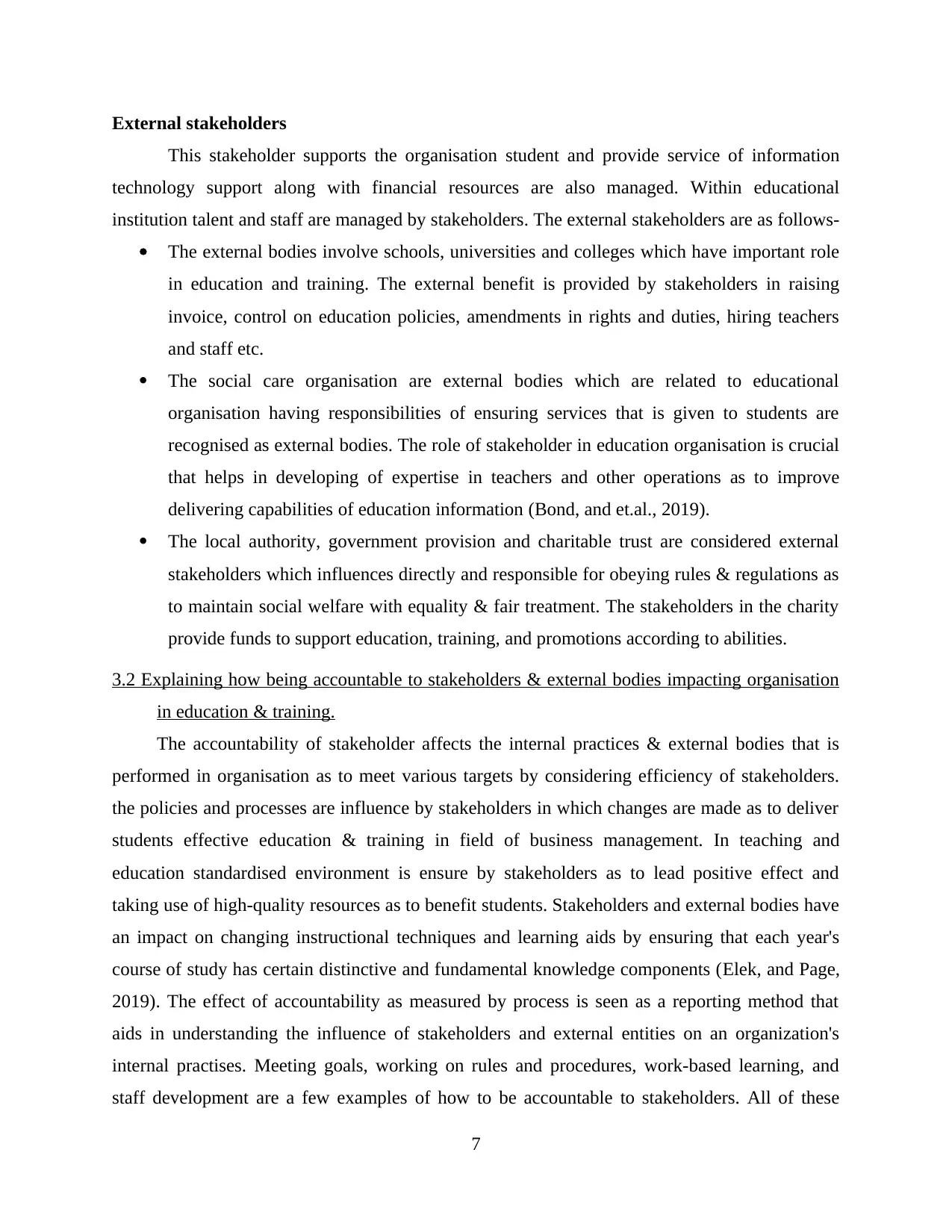
External stakeholders
This stakeholder supports the organisation student and provide service of information
technology support along with financial resources are also managed. Within educational
institution talent and staff are managed by stakeholders. The external stakeholders are as follows-
The external bodies involve schools, universities and colleges which have important role
in education and training. The external benefit is provided by stakeholders in raising
invoice, control on education policies, amendments in rights and duties, hiring teachers
and staff etc.
The social care organisation are external bodies which are related to educational
organisation having responsibilities of ensuring services that is given to students are
recognised as external bodies. The role of stakeholder in education organisation is crucial
that helps in developing of expertise in teachers and other operations as to improve
delivering capabilities of education information (Bond, and et.al., 2019).
The local authority, government provision and charitable trust are considered external
stakeholders which influences directly and responsible for obeying rules & regulations as
to maintain social welfare with equality & fair treatment. The stakeholders in the charity
provide funds to support education, training, and promotions according to abilities.
3.2 Explaining how being accountable to stakeholders & external bodies impacting organisation
in education & training.
The accountability of stakeholder affects the internal practices & external bodies that is
performed in organisation as to meet various targets by considering efficiency of stakeholders.
the policies and processes are influence by stakeholders in which changes are made as to deliver
students effective education & training in field of business management. In teaching and
education standardised environment is ensure by stakeholders as to lead positive effect and
taking use of high-quality resources as to benefit students. Stakeholders and external bodies have
an impact on changing instructional techniques and learning aids by ensuring that each year's
course of study has certain distinctive and fundamental knowledge components (Elek, and Page,
2019). The effect of accountability as measured by process is seen as a reporting method that
aids in understanding the influence of stakeholders and external entities on an organization's
internal practises. Meeting goals, working on rules and procedures, work-based learning, and
staff development are a few examples of how to be accountable to stakeholders. All of these
7
This stakeholder supports the organisation student and provide service of information
technology support along with financial resources are also managed. Within educational
institution talent and staff are managed by stakeholders. The external stakeholders are as follows-
The external bodies involve schools, universities and colleges which have important role
in education and training. The external benefit is provided by stakeholders in raising
invoice, control on education policies, amendments in rights and duties, hiring teachers
and staff etc.
The social care organisation are external bodies which are related to educational
organisation having responsibilities of ensuring services that is given to students are
recognised as external bodies. The role of stakeholder in education organisation is crucial
that helps in developing of expertise in teachers and other operations as to improve
delivering capabilities of education information (Bond, and et.al., 2019).
The local authority, government provision and charitable trust are considered external
stakeholders which influences directly and responsible for obeying rules & regulations as
to maintain social welfare with equality & fair treatment. The stakeholders in the charity
provide funds to support education, training, and promotions according to abilities.
3.2 Explaining how being accountable to stakeholders & external bodies impacting organisation
in education & training.
The accountability of stakeholder affects the internal practices & external bodies that is
performed in organisation as to meet various targets by considering efficiency of stakeholders.
the policies and processes are influence by stakeholders in which changes are made as to deliver
students effective education & training in field of business management. In teaching and
education standardised environment is ensure by stakeholders as to lead positive effect and
taking use of high-quality resources as to benefit students. Stakeholders and external bodies have
an impact on changing instructional techniques and learning aids by ensuring that each year's
course of study has certain distinctive and fundamental knowledge components (Elek, and Page,
2019). The effect of accountability as measured by process is seen as a reporting method that
aids in understanding the influence of stakeholders and external entities on an organization's
internal practises. Meeting goals, working on rules and procedures, work-based learning, and
staff development are a few examples of how to be accountable to stakeholders. All of these
7
Secure Best Marks with AI Grader
Need help grading? Try our AI Grader for instant feedback on your assignments.
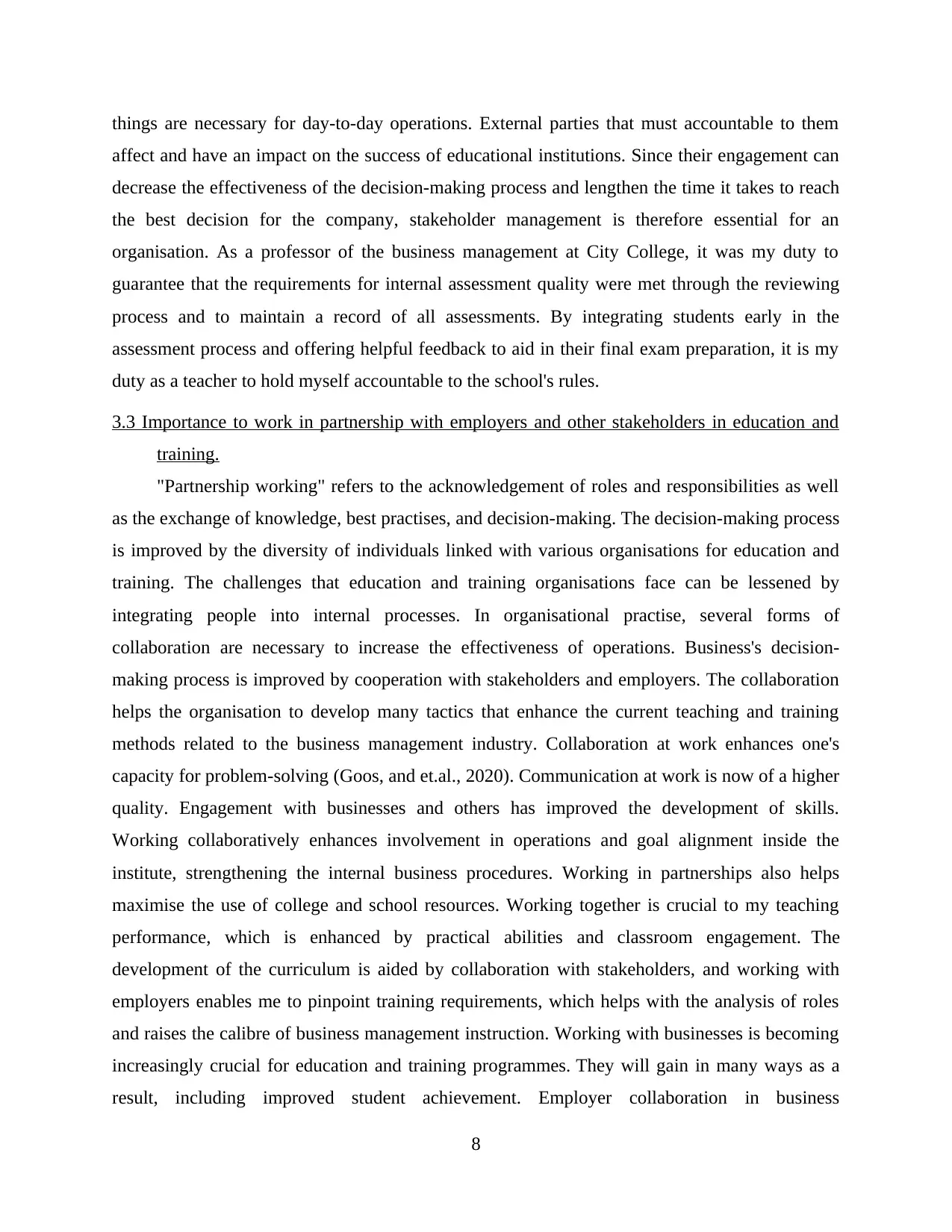
things are necessary for day-to-day operations. External parties that must accountable to them
affect and have an impact on the success of educational institutions. Since their engagement can
decrease the effectiveness of the decision-making process and lengthen the time it takes to reach
the best decision for the company, stakeholder management is therefore essential for an
organisation. As a professor of the business management at City College, it was my duty to
guarantee that the requirements for internal assessment quality were met through the reviewing
process and to maintain a record of all assessments. By integrating students early in the
assessment process and offering helpful feedback to aid in their final exam preparation, it is my
duty as a teacher to hold myself accountable to the school's rules.
3.3 Importance to work in partnership with employers and other stakeholders in education and
training.
"Partnership working" refers to the acknowledgement of roles and responsibilities as well
as the exchange of knowledge, best practises, and decision-making. The decision-making process
is improved by the diversity of individuals linked with various organisations for education and
training. The challenges that education and training organisations face can be lessened by
integrating people into internal processes. In organisational practise, several forms of
collaboration are necessary to increase the effectiveness of operations. Business's decision-
making process is improved by cooperation with stakeholders and employers. The collaboration
helps the organisation to develop many tactics that enhance the current teaching and training
methods related to the business management industry. Collaboration at work enhances one's
capacity for problem-solving (Goos, and et.al., 2020). Communication at work is now of a higher
quality. Engagement with businesses and others has improved the development of skills.
Working collaboratively enhances involvement in operations and goal alignment inside the
institute, strengthening the internal business procedures. Working in partnerships also helps
maximise the use of college and school resources. Working together is crucial to my teaching
performance, which is enhanced by practical abilities and classroom engagement. The
development of the curriculum is aided by collaboration with stakeholders, and working with
employers enables me to pinpoint training requirements, which helps with the analysis of roles
and raises the calibre of business management instruction. Working with businesses is becoming
increasingly crucial for education and training programmes. They will gain in many ways as a
result, including improved student achievement. Employer collaboration in business
8
affect and have an impact on the success of educational institutions. Since their engagement can
decrease the effectiveness of the decision-making process and lengthen the time it takes to reach
the best decision for the company, stakeholder management is therefore essential for an
organisation. As a professor of the business management at City College, it was my duty to
guarantee that the requirements for internal assessment quality were met through the reviewing
process and to maintain a record of all assessments. By integrating students early in the
assessment process and offering helpful feedback to aid in their final exam preparation, it is my
duty as a teacher to hold myself accountable to the school's rules.
3.3 Importance to work in partnership with employers and other stakeholders in education and
training.
"Partnership working" refers to the acknowledgement of roles and responsibilities as well
as the exchange of knowledge, best practises, and decision-making. The decision-making process
is improved by the diversity of individuals linked with various organisations for education and
training. The challenges that education and training organisations face can be lessened by
integrating people into internal processes. In organisational practise, several forms of
collaboration are necessary to increase the effectiveness of operations. Business's decision-
making process is improved by cooperation with stakeholders and employers. The collaboration
helps the organisation to develop many tactics that enhance the current teaching and training
methods related to the business management industry. Collaboration at work enhances one's
capacity for problem-solving (Goos, and et.al., 2020). Communication at work is now of a higher
quality. Engagement with businesses and others has improved the development of skills.
Working collaboratively enhances involvement in operations and goal alignment inside the
institute, strengthening the internal business procedures. Working in partnerships also helps
maximise the use of college and school resources. Working together is crucial to my teaching
performance, which is enhanced by practical abilities and classroom engagement. The
development of the curriculum is aided by collaboration with stakeholders, and working with
employers enables me to pinpoint training requirements, which helps with the analysis of roles
and raises the calibre of business management instruction. Working with businesses is becoming
increasingly crucial for education and training programmes. They will gain in many ways as a
result, including improved student achievement. Employer collaboration in business
8
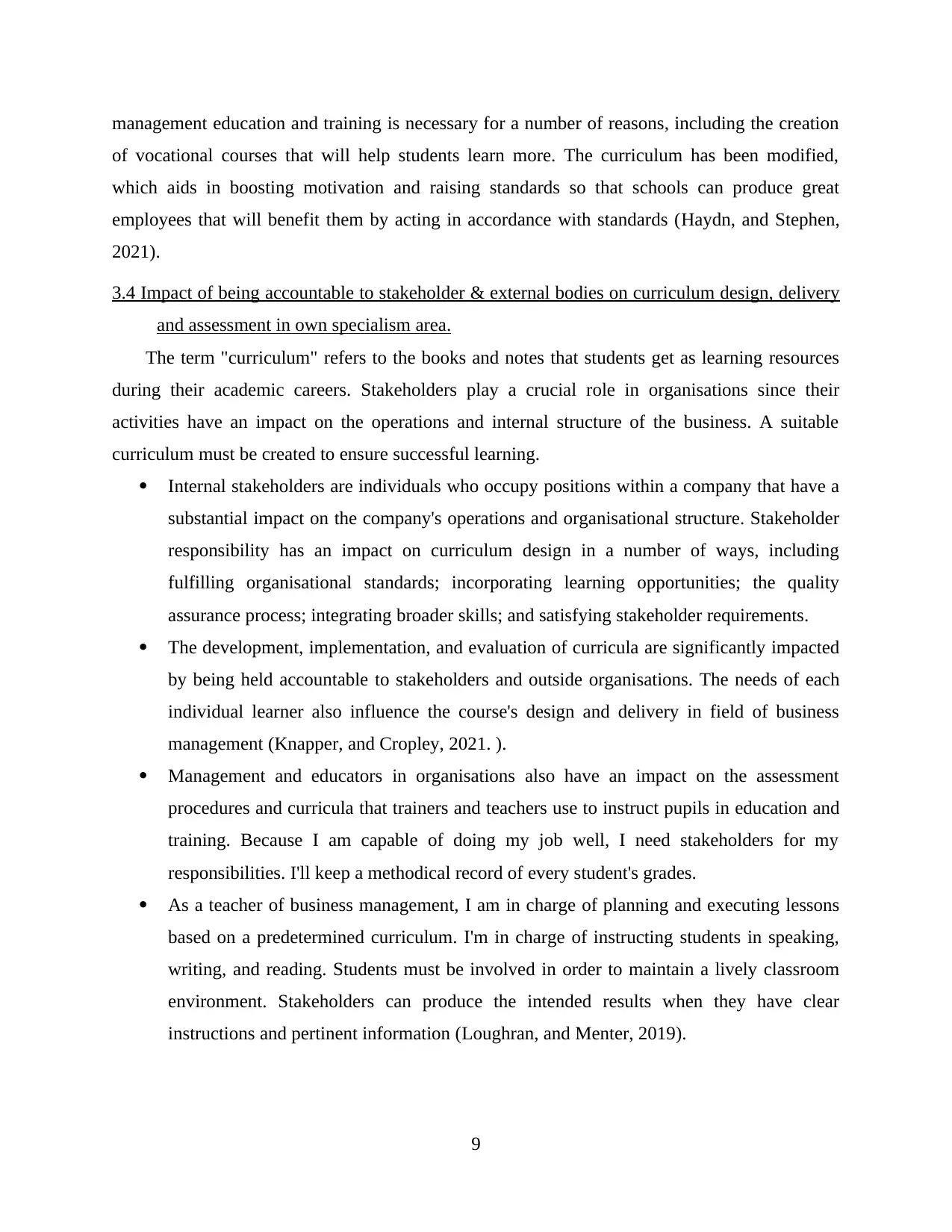
management education and training is necessary for a number of reasons, including the creation
of vocational courses that will help students learn more. The curriculum has been modified,
which aids in boosting motivation and raising standards so that schools can produce great
employees that will benefit them by acting in accordance with standards (Haydn, and Stephen,
2021).
3.4 Impact of being accountable to stakeholder & external bodies on curriculum design, delivery
and assessment in own specialism area.
The term "curriculum" refers to the books and notes that students get as learning resources
during their academic careers. Stakeholders play a crucial role in organisations since their
activities have an impact on the operations and internal structure of the business. A suitable
curriculum must be created to ensure successful learning.
Internal stakeholders are individuals who occupy positions within a company that have a
substantial impact on the company's operations and organisational structure. Stakeholder
responsibility has an impact on curriculum design in a number of ways, including
fulfilling organisational standards; incorporating learning opportunities; the quality
assurance process; integrating broader skills; and satisfying stakeholder requirements.
The development, implementation, and evaluation of curricula are significantly impacted
by being held accountable to stakeholders and outside organisations. The needs of each
individual learner also influence the course's design and delivery in field of business
management (Knapper, and Cropley, 2021. ).
Management and educators in organisations also have an impact on the assessment
procedures and curricula that trainers and teachers use to instruct pupils in education and
training. Because I am capable of doing my job well, I need stakeholders for my
responsibilities. I'll keep a methodical record of every student's grades.
As a teacher of business management, I am in charge of planning and executing lessons
based on a predetermined curriculum. I'm in charge of instructing students in speaking,
writing, and reading. Students must be involved in order to maintain a lively classroom
environment. Stakeholders can produce the intended results when they have clear
instructions and pertinent information (Loughran, and Menter, 2019).
9
of vocational courses that will help students learn more. The curriculum has been modified,
which aids in boosting motivation and raising standards so that schools can produce great
employees that will benefit them by acting in accordance with standards (Haydn, and Stephen,
2021).
3.4 Impact of being accountable to stakeholder & external bodies on curriculum design, delivery
and assessment in own specialism area.
The term "curriculum" refers to the books and notes that students get as learning resources
during their academic careers. Stakeholders play a crucial role in organisations since their
activities have an impact on the operations and internal structure of the business. A suitable
curriculum must be created to ensure successful learning.
Internal stakeholders are individuals who occupy positions within a company that have a
substantial impact on the company's operations and organisational structure. Stakeholder
responsibility has an impact on curriculum design in a number of ways, including
fulfilling organisational standards; incorporating learning opportunities; the quality
assurance process; integrating broader skills; and satisfying stakeholder requirements.
The development, implementation, and evaluation of curricula are significantly impacted
by being held accountable to stakeholders and outside organisations. The needs of each
individual learner also influence the course's design and delivery in field of business
management (Knapper, and Cropley, 2021. ).
Management and educators in organisations also have an impact on the assessment
procedures and curricula that trainers and teachers use to instruct pupils in education and
training. Because I am capable of doing my job well, I need stakeholders for my
responsibilities. I'll keep a methodical record of every student's grades.
As a teacher of business management, I am in charge of planning and executing lessons
based on a predetermined curriculum. I'm in charge of instructing students in speaking,
writing, and reading. Students must be involved in order to maintain a lively classroom
environment. Stakeholders can produce the intended results when they have clear
instructions and pertinent information (Loughran, and Menter, 2019).
9
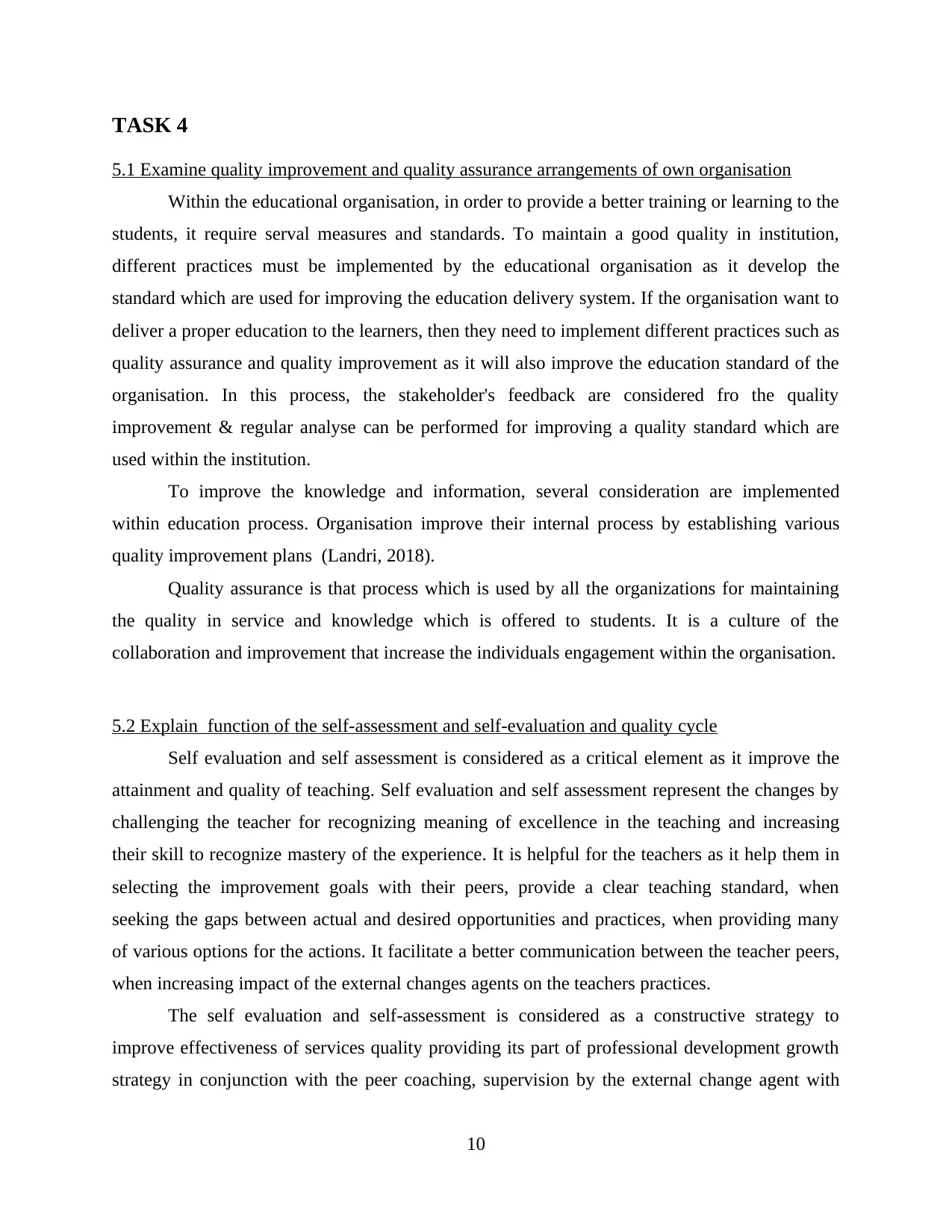
TASK 4
5.1 Examine quality improvement and quality assurance arrangements of own organisation
Within the educational organisation, in order to provide a better training or learning to the
students, it require serval measures and standards. To maintain a good quality in institution,
different practices must be implemented by the educational organisation as it develop the
standard which are used for improving the education delivery system. If the organisation want to
deliver a proper education to the learners, then they need to implement different practices such as
quality assurance and quality improvement as it will also improve the education standard of the
organisation. In this process, the stakeholder's feedback are considered fro the quality
improvement & regular analyse can be performed for improving a quality standard which are
used within the institution.
To improve the knowledge and information, several consideration are implemented
within education process. Organisation improve their internal process by establishing various
quality improvement plans (Landri, 2018).
Quality assurance is that process which is used by all the organizations for maintaining
the quality in service and knowledge which is offered to students. It is a culture of the
collaboration and improvement that increase the individuals engagement within the organisation.
5.2 Explain function of the self-assessment and self-evaluation and quality cycle
Self evaluation and self assessment is considered as a critical element as it improve the
attainment and quality of teaching. Self evaluation and self assessment represent the changes by
challenging the teacher for recognizing meaning of excellence in the teaching and increasing
their skill to recognize mastery of the experience. It is helpful for the teachers as it help them in
selecting the improvement goals with their peers, provide a clear teaching standard, when
seeking the gaps between actual and desired opportunities and practices, when providing many
of various options for the actions. It facilitate a better communication between the teacher peers,
when increasing impact of the external changes agents on the teachers practices.
The self evaluation and self-assessment is considered as a constructive strategy to
improve effectiveness of services quality providing its part of professional development growth
strategy in conjunction with the peer coaching, supervision by the external change agent with
10
5.1 Examine quality improvement and quality assurance arrangements of own organisation
Within the educational organisation, in order to provide a better training or learning to the
students, it require serval measures and standards. To maintain a good quality in institution,
different practices must be implemented by the educational organisation as it develop the
standard which are used for improving the education delivery system. If the organisation want to
deliver a proper education to the learners, then they need to implement different practices such as
quality assurance and quality improvement as it will also improve the education standard of the
organisation. In this process, the stakeholder's feedback are considered fro the quality
improvement & regular analyse can be performed for improving a quality standard which are
used within the institution.
To improve the knowledge and information, several consideration are implemented
within education process. Organisation improve their internal process by establishing various
quality improvement plans (Landri, 2018).
Quality assurance is that process which is used by all the organizations for maintaining
the quality in service and knowledge which is offered to students. It is a culture of the
collaboration and improvement that increase the individuals engagement within the organisation.
5.2 Explain function of the self-assessment and self-evaluation and quality cycle
Self evaluation and self assessment is considered as a critical element as it improve the
attainment and quality of teaching. Self evaluation and self assessment represent the changes by
challenging the teacher for recognizing meaning of excellence in the teaching and increasing
their skill to recognize mastery of the experience. It is helpful for the teachers as it help them in
selecting the improvement goals with their peers, provide a clear teaching standard, when
seeking the gaps between actual and desired opportunities and practices, when providing many
of various options for the actions. It facilitate a better communication between the teacher peers,
when increasing impact of the external changes agents on the teachers practices.
The self evaluation and self-assessment is considered as a constructive strategy to
improve effectiveness of services quality providing its part of professional development growth
strategy in conjunction with the peer coaching, supervision by the external change agent with
10
Paraphrase This Document
Need a fresh take? Get an instant paraphrase of this document with our AI Paraphraser
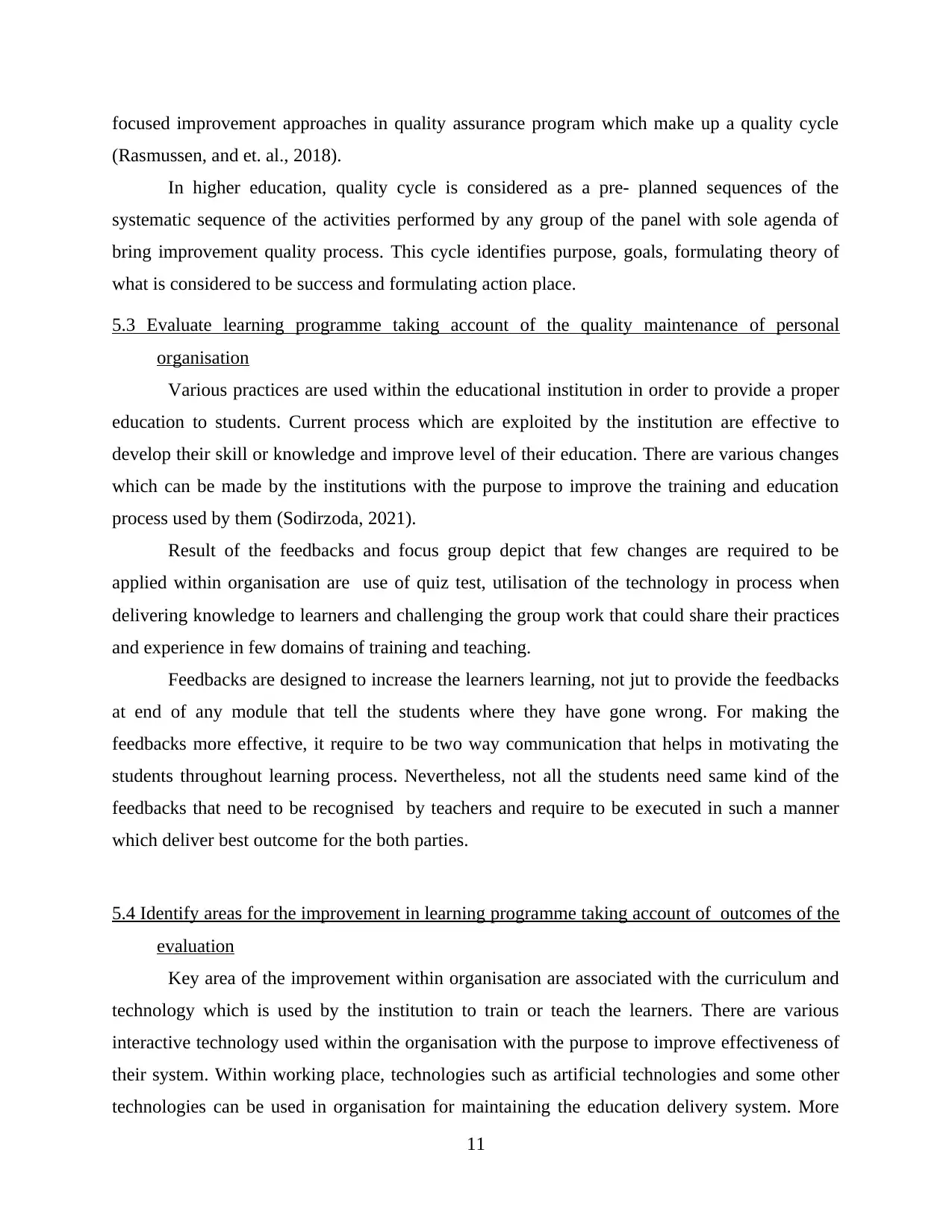
focused improvement approaches in quality assurance program which make up a quality cycle
(Rasmussen, and et. al., 2018).
In higher education, quality cycle is considered as a pre- planned sequences of the
systematic sequence of the activities performed by any group of the panel with sole agenda of
bring improvement quality process. This cycle identifies purpose, goals, formulating theory of
what is considered to be success and formulating action place.
5.3 Evaluate learning programme taking account of the quality maintenance of personal
organisation
Various practices are used within the educational institution in order to provide a proper
education to students. Current process which are exploited by the institution are effective to
develop their skill or knowledge and improve level of their education. There are various changes
which can be made by the institutions with the purpose to improve the training and education
process used by them (Sodirzoda, 2021).
Result of the feedbacks and focus group depict that few changes are required to be
applied within organisation are use of quiz test, utilisation of the technology in process when
delivering knowledge to learners and challenging the group work that could share their practices
and experience in few domains of training and teaching.
Feedbacks are designed to increase the learners learning, not jut to provide the feedbacks
at end of any module that tell the students where they have gone wrong. For making the
feedbacks more effective, it require to be two way communication that helps in motivating the
students throughout learning process. Nevertheless, not all the students need same kind of the
feedbacks that need to be recognised by teachers and require to be executed in such a manner
which deliver best outcome for the both parties.
5.4 Identify areas for the improvement in learning programme taking account of outcomes of the
evaluation
Key area of the improvement within organisation are associated with the curriculum and
technology which is used by the institution to train or teach the learners. There are various
interactive technology used within the organisation with the purpose to improve effectiveness of
their system. Within working place, technologies such as artificial technologies and some other
technologies can be used in organisation for maintaining the education delivery system. More
11
(Rasmussen, and et. al., 2018).
In higher education, quality cycle is considered as a pre- planned sequences of the
systematic sequence of the activities performed by any group of the panel with sole agenda of
bring improvement quality process. This cycle identifies purpose, goals, formulating theory of
what is considered to be success and formulating action place.
5.3 Evaluate learning programme taking account of the quality maintenance of personal
organisation
Various practices are used within the educational institution in order to provide a proper
education to students. Current process which are exploited by the institution are effective to
develop their skill or knowledge and improve level of their education. There are various changes
which can be made by the institutions with the purpose to improve the training and education
process used by them (Sodirzoda, 2021).
Result of the feedbacks and focus group depict that few changes are required to be
applied within organisation are use of quiz test, utilisation of the technology in process when
delivering knowledge to learners and challenging the group work that could share their practices
and experience in few domains of training and teaching.
Feedbacks are designed to increase the learners learning, not jut to provide the feedbacks
at end of any module that tell the students where they have gone wrong. For making the
feedbacks more effective, it require to be two way communication that helps in motivating the
students throughout learning process. Nevertheless, not all the students need same kind of the
feedbacks that need to be recognised by teachers and require to be executed in such a manner
which deliver best outcome for the both parties.
5.4 Identify areas for the improvement in learning programme taking account of outcomes of the
evaluation
Key area of the improvement within organisation are associated with the curriculum and
technology which is used by the institution to train or teach the learners. There are various
interactive technology used within the organisation with the purpose to improve effectiveness of
their system. Within working place, technologies such as artificial technologies and some other
technologies can be used in organisation for maintaining the education delivery system. More
11
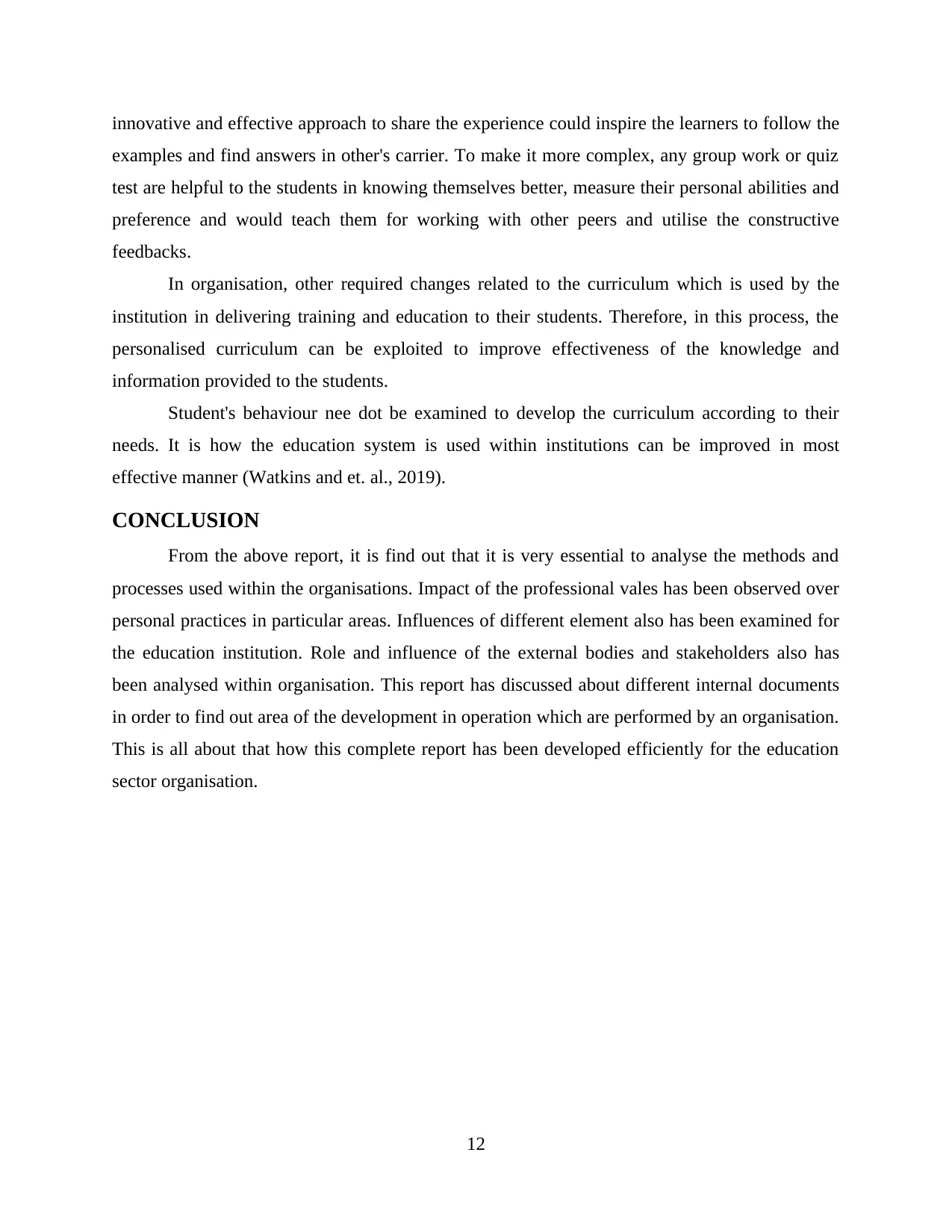
innovative and effective approach to share the experience could inspire the learners to follow the
examples and find answers in other's carrier. To make it more complex, any group work or quiz
test are helpful to the students in knowing themselves better, measure their personal abilities and
preference and would teach them for working with other peers and utilise the constructive
feedbacks.
In organisation, other required changes related to the curriculum which is used by the
institution in delivering training and education to their students. Therefore, in this process, the
personalised curriculum can be exploited to improve effectiveness of the knowledge and
information provided to the students.
Student's behaviour nee dot be examined to develop the curriculum according to their
needs. It is how the education system is used within institutions can be improved in most
effective manner (Watkins and et. al., 2019).
CONCLUSION
From the above report, it is find out that it is very essential to analyse the methods and
processes used within the organisations. Impact of the professional vales has been observed over
personal practices in particular areas. Influences of different element also has been examined for
the education institution. Role and influence of the external bodies and stakeholders also has
been analysed within organisation. This report has discussed about different internal documents
in order to find out area of the development in operation which are performed by an organisation.
This is all about that how this complete report has been developed efficiently for the education
sector organisation.
12
examples and find answers in other's carrier. To make it more complex, any group work or quiz
test are helpful to the students in knowing themselves better, measure their personal abilities and
preference and would teach them for working with other peers and utilise the constructive
feedbacks.
In organisation, other required changes related to the curriculum which is used by the
institution in delivering training and education to their students. Therefore, in this process, the
personalised curriculum can be exploited to improve effectiveness of the knowledge and
information provided to the students.
Student's behaviour nee dot be examined to develop the curriculum according to their
needs. It is how the education system is used within institutions can be improved in most
effective manner (Watkins and et. al., 2019).
CONCLUSION
From the above report, it is find out that it is very essential to analyse the methods and
processes used within the organisations. Impact of the professional vales has been observed over
personal practices in particular areas. Influences of different element also has been examined for
the education institution. Role and influence of the external bodies and stakeholders also has
been analysed within organisation. This report has discussed about different internal documents
in order to find out area of the development in operation which are performed by an organisation.
This is all about that how this complete report has been developed efficiently for the education
sector organisation.
12
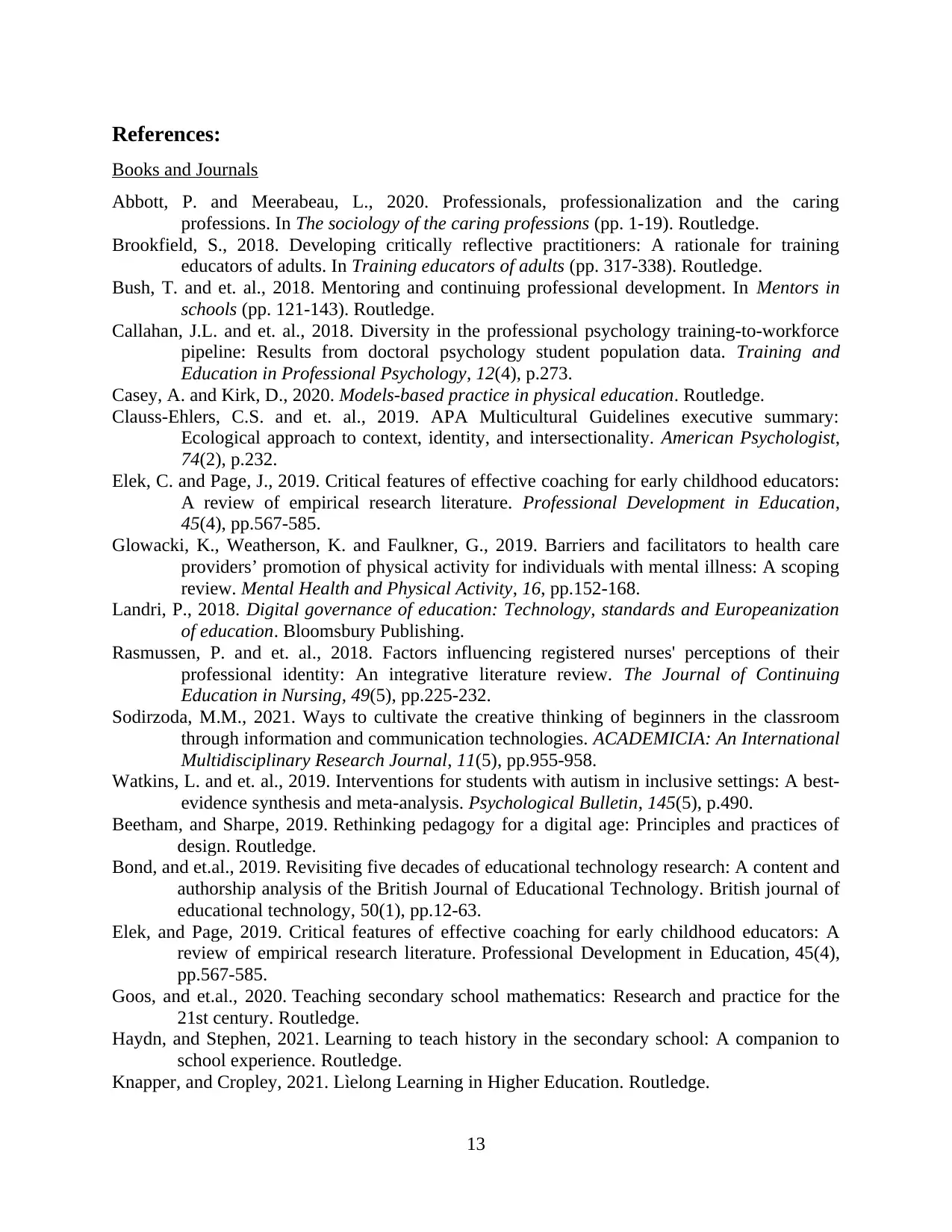
References:
Books and Journals
Abbott, P. and Meerabeau, L., 2020. Professionals, professionalization and the caring
professions. In The sociology of the caring professions (pp. 1-19). Routledge.
Brookfield, S., 2018. Developing critically reflective practitioners: A rationale for training
educators of adults. In Training educators of adults (pp. 317-338). Routledge.
Bush, T. and et. al., 2018. Mentoring and continuing professional development. In Mentors in
schools (pp. 121-143). Routledge.
Callahan, J.L. and et. al., 2018. Diversity in the professional psychology training-to-workforce
pipeline: Results from doctoral psychology student population data. Training and
Education in Professional Psychology, 12(4), p.273.
Casey, A. and Kirk, D., 2020. Models-based practice in physical education. Routledge.
Clauss-Ehlers, C.S. and et. al., 2019. APA Multicultural Guidelines executive summary:
Ecological approach to context, identity, and intersectionality. American Psychologist,
74(2), p.232.
Elek, C. and Page, J., 2019. Critical features of effective coaching for early childhood educators:
A review of empirical research literature. Professional Development in Education,
45(4), pp.567-585.
Glowacki, K., Weatherson, K. and Faulkner, G., 2019. Barriers and facilitators to health care
providers’ promotion of physical activity for individuals with mental illness: A scoping
review. Mental Health and Physical Activity, 16, pp.152-168.
Landri, P., 2018. Digital governance of education: Technology, standards and Europeanization
of education. Bloomsbury Publishing.
Rasmussen, P. and et. al., 2018. Factors influencing registered nurses' perceptions of their
professional identity: An integrative literature review. The Journal of Continuing
Education in Nursing, 49(5), pp.225-232.
Sodirzoda, M.M., 2021. Ways to cultivate the creative thinking of beginners in the classroom
through information and communication technologies. ACADEMICIA: An International
Multidisciplinary Research Journal, 11(5), pp.955-958.
Watkins, L. and et. al., 2019. Interventions for students with autism in inclusive settings: A best-
evidence synthesis and meta-analysis. Psychological Bulletin, 145(5), p.490.
Beetham, and Sharpe, 2019. Rethinking pedagogy for a digital age: Principles and practices of
design. Routledge.
Bond, and et.al., 2019. Revisiting five decades of educational technology research: A content and
authorship analysis of the British Journal of Educational Technology. British journal of
educational technology, 50(1), pp.12-63.
Elek, and Page, 2019. Critical features of effective coaching for early childhood educators: A
review of empirical research literature. Professional Development in Education, 45(4),
pp.567-585.
Goos, and et.al., 2020. Teaching secondary school mathematics: Research and practice for the
21st century. Routledge.
Haydn, and Stephen, 2021. Learning to teach history in the secondary school: A companion to
school experience. Routledge.
Knapper, and Cropley, 2021. Lìelong Learning in Higher Education. Routledge.
13
Books and Journals
Abbott, P. and Meerabeau, L., 2020. Professionals, professionalization and the caring
professions. In The sociology of the caring professions (pp. 1-19). Routledge.
Brookfield, S., 2018. Developing critically reflective practitioners: A rationale for training
educators of adults. In Training educators of adults (pp. 317-338). Routledge.
Bush, T. and et. al., 2018. Mentoring and continuing professional development. In Mentors in
schools (pp. 121-143). Routledge.
Callahan, J.L. and et. al., 2018. Diversity in the professional psychology training-to-workforce
pipeline: Results from doctoral psychology student population data. Training and
Education in Professional Psychology, 12(4), p.273.
Casey, A. and Kirk, D., 2020. Models-based practice in physical education. Routledge.
Clauss-Ehlers, C.S. and et. al., 2019. APA Multicultural Guidelines executive summary:
Ecological approach to context, identity, and intersectionality. American Psychologist,
74(2), p.232.
Elek, C. and Page, J., 2019. Critical features of effective coaching for early childhood educators:
A review of empirical research literature. Professional Development in Education,
45(4), pp.567-585.
Glowacki, K., Weatherson, K. and Faulkner, G., 2019. Barriers and facilitators to health care
providers’ promotion of physical activity for individuals with mental illness: A scoping
review. Mental Health and Physical Activity, 16, pp.152-168.
Landri, P., 2018. Digital governance of education: Technology, standards and Europeanization
of education. Bloomsbury Publishing.
Rasmussen, P. and et. al., 2018. Factors influencing registered nurses' perceptions of their
professional identity: An integrative literature review. The Journal of Continuing
Education in Nursing, 49(5), pp.225-232.
Sodirzoda, M.M., 2021. Ways to cultivate the creative thinking of beginners in the classroom
through information and communication technologies. ACADEMICIA: An International
Multidisciplinary Research Journal, 11(5), pp.955-958.
Watkins, L. and et. al., 2019. Interventions for students with autism in inclusive settings: A best-
evidence synthesis and meta-analysis. Psychological Bulletin, 145(5), p.490.
Beetham, and Sharpe, 2019. Rethinking pedagogy for a digital age: Principles and practices of
design. Routledge.
Bond, and et.al., 2019. Revisiting five decades of educational technology research: A content and
authorship analysis of the British Journal of Educational Technology. British journal of
educational technology, 50(1), pp.12-63.
Elek, and Page, 2019. Critical features of effective coaching for early childhood educators: A
review of empirical research literature. Professional Development in Education, 45(4),
pp.567-585.
Goos, and et.al., 2020. Teaching secondary school mathematics: Research and practice for the
21st century. Routledge.
Haydn, and Stephen, 2021. Learning to teach history in the secondary school: A companion to
school experience. Routledge.
Knapper, and Cropley, 2021. Lìelong Learning in Higher Education. Routledge.
13
Secure Best Marks with AI Grader
Need help grading? Try our AI Grader for instant feedback on your assignments.
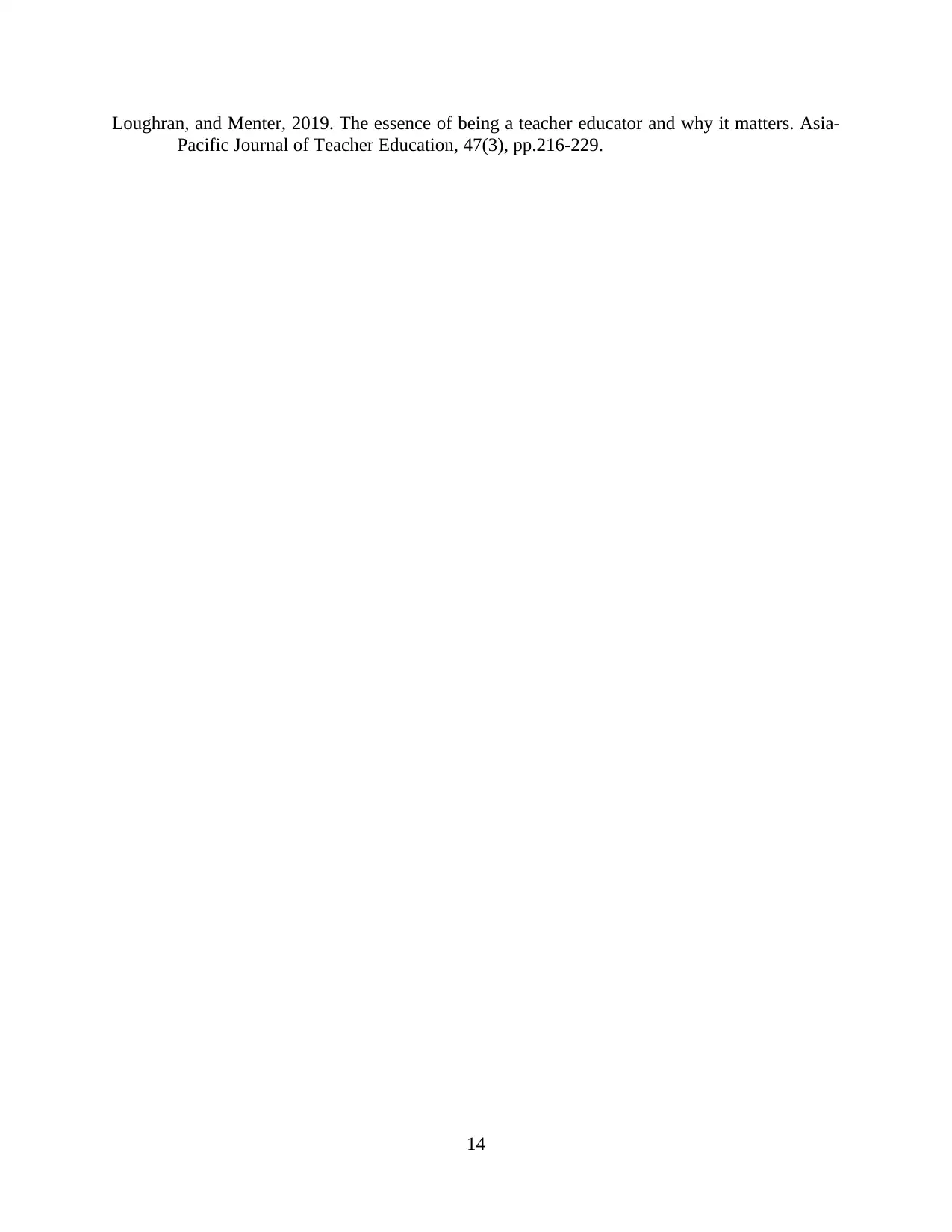
Loughran, and Menter, 2019. The essence of being a teacher educator and why it matters. Asia-
Pacific Journal of Teacher Education, 47(3), pp.216-229.
14
Pacific Journal of Teacher Education, 47(3), pp.216-229.
14
1 out of 17
Related Documents
Your All-in-One AI-Powered Toolkit for Academic Success.
+13062052269
info@desklib.com
Available 24*7 on WhatsApp / Email
![[object Object]](/_next/static/media/star-bottom.7253800d.svg)
Unlock your academic potential
© 2024 | Zucol Services PVT LTD | All rights reserved.

